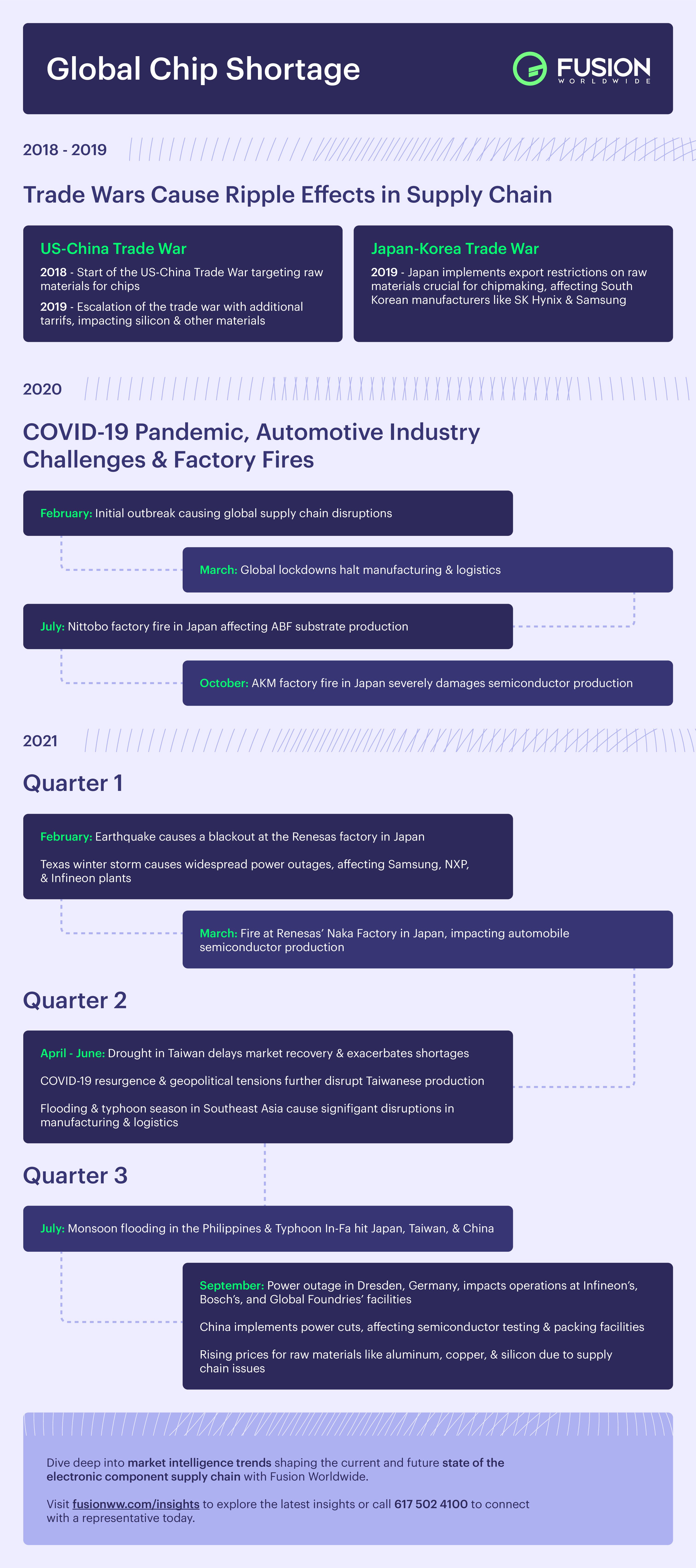THE GLOBAL CHIP SHORTAGE: A TIMELINE OF UNFORTUNATE EVENTS
COVID-19 has sent traumatic ripples through supply chains around the globe, but the semiconductor supply chain was fragile long before governments shut down and catastrophe struck. In a culmination of negative variables, the chip shortage has amassed over the years from a series of unfortunate events. Events include trade wars between countries that impact commodity pricing and distribution, natural disasters like the drought in Taiwan and a winter storm in Texas that damaged major factories, and incidents like the three separate plant fires in Japan between 2019 and 2021 that have been devastating to operation and contributed to raw material shortages as well.
The woes that chipmakers experience appear endless even among plans for major companies to expand to meet demand as countries vie to be crowned lead global chipmaker. Each phenomenon has contributed to the current market volatility and will continue to impact the outlook for companies as chipmakers expect the shortages to continue in the years to come.
2018 and 2019 - Trade Wars Cause Ripple Effects in Supply Chain
When Did the Chip Shortage Start?
The US–China and Japan–Korea trade wars have caused significant market turbulence, raising concerns for chipmakers over the effects geopolitical conflicts had on manufacturing and distribution. Both trade wars caused increased lead times, raised pricing, and contributed to constraints on raw materials.
US–China Trade War:
Starting in 2018, the US–China trade war unfolded in five phases through 2021. “The trade war took direct aim at Beijing’s ambitions to become a leader in advanced manufacturing technologies such as semiconductors and electric vehicles," reported The Wall Street Journal. The first wave of tariffs that directly impacted chipmaking hit Chinese imports in 2018. It targeted raw materials for chips, such as silicon and reactor tubes and holders designed for semiconductor wafer production.
In a ripple effect, the tariffs that hit these raw materials were one of three main factors that led to the 8-inch (20mm) wafer shortage reported in Q3 2019, which persists today; the other factors were increased end-product demand and an uneven supply of foundry equipment. The tension between the US and China further caused wafer supply hoarding when the US later blacklisted China’s biggest chipmaker, SMIC, in 2020. With many vital parts of the supply chain impacted, US industries reliant on semiconductors feared that restrictions on Chinese imports would lead China to create their own semiconductor ecosystem, even if they’d have to play catch-up with US chip designs.
In August 2019, the trade war escalated as Beijing announced it would apply $75 billion in tariffs on US goods. The last phase of US tariffs in September 2019 targeted $120 billion worth of Chinese goods. In 2019, the US and China made an agreement that included structural reforms and changes to China’s economic and trade regime. The hope was that when this agreement later went into effect, it would reduce the back-and-forth tariff increases on imports.
Japan – Korea Trade War:
The Japan – Korea trade war that began in 2019 commenced with Japan implementing export restrictions on raw materials used to make chips. Major semiconductor manufacturers SK Hynix and Samsung, both headquartered in South Korea, were caught in the crosshairs trying to secure inventory to buffer production against disruption. The major chipmakers in South Korea were heavily dependent on chemicals produced by Japan vital to chipmaking. The already lingering concern of the semiconductor supply chain from tensions between the US and China heightened as a result of this additional disruption to the production of chips coming out of Asia.
2020 – No Reprieve Amid Escalating Shortages
Semiconductor Supply Chain
In 2020, COVID-19 struck. Manufacturers in all industries scrambled to meet supply and demand in an unprecedented economic climate. For chipmakers, production was halted for almost half of the year due to government shutdowns and COVID-19 restrictions. By the time production did resume, semiconductor companies had to adjust to increased pressure from various sectors.
Auto Industry Challenges
The automotive industry experienced a surge in demand as purchasing behavior shifted in the second half of the year as consumers avoided public transportation due to the pandemic and developed an increased desire for customization in vehicles. Recovery for automakers was hindered as the supply chain experienced shortages in 8-inch wafers and ABF substrates necessary for semiconductors manufactured in cars. In response, automakers like Volkswagen, Ford, and Toyota cut production at a time when the industry was on the precipice of a boom.
Raw Material Shortages and Price Increases
Raw materials shortages continued to intensify due to capacity restraints, unpredictability of the COVID-19 pandemic, and the unforeseen events that struck chipmakers globally. The 8-inch wafer shortage snowballed from 2019 due to higher demand in the IC market, increased tension between the US and China, and growth in 5G and automotive sectors – which led wafer production capacity to reach 99% in 2020.
Impact of Nittobo and AKM Factory Fires

The ABF substrate shortage was exacerbated after a fire impacted production for Japanese manufacturer Nittobo in July 2020. Although ABF suppliers tried to increase production for the months ahead, but with high demand for semiconductors, backlogs and lead times were predicted to extend into late 2021.
Another fire broke out at the Asahi Kasei Microdevices (AKM) semiconductor plant in Miyazaki, Japan, in October 2020, which left the factory severely damaged and out of operation. The semiconductor manufacturer communicated to customers that they should switch to alternative products and they would work with a third-party manufacturer until the AKM plant could reopen. Panic ensued in the market, which led prices to skyrocket in the days following the fire. Customers stocked up on supplies in an attempt to prevent further disruption in their supply chains.
Resilience in the Semiconductor Supply Chain Issues
In 2020, the pandemic, raw material shortages, and surging demand all weighed on semiconductor manufacturers, with no reprieve in sight. For global chipmakers to adjust, building supply chain resiliency became essential for global chipmakers to mitigate semiconductor shortages and reduce disruptions.
2021 – An Opportunity for Growth in Global Supply Chains, but will Industries Persevere?
After a tumultuous year in 2020, it appeared there might be some light at the end of a long, long tunnel for some industries in 2021. Optimism grew with the rollout of 5G, the potential rebound of the automotive sector, a heightened need for data centers, and increasing reliance on AI and IoT would mean growth for businesses. However, shortages that were originally attributed to the pandemic continued to worsen with demand growth, raw material shortages, and ongoing catastrophes. In Q1 2021, distributor inventories were under allocation, and end-customer supply was very tight for a variety of components.
Challenges in Q1 and Q2 2021
The first quarter led to another dark tunnel for global markets that rolled into Q2 2021, which unfolded as chipmakers continued to struggle to fulfill orders across a variety of industries—a struggle that would force companies to decrease their production lines or stop them altogether.
Renesas Factory Fire
Semiconductor production took additional hits when Renesas’s Naka factory in Japan experienced two detrimental blows in a brief time period, further impacting the wafer shortage that originally began in 2019. The first hit to the factory occurred in February 2021 when an earthquake caused a blackout that temporarily suspended production but had minimal repercussions. The second blow struck the same factory when a fire broke out in March. The fire affected a building where two-thirds of the wafers produced were used in automobile production, creating additional woes for automakers.
Texas Winter Storm Disruptions
Concurrently, in February, the commodity chip supply chain suffered another disruption when Texas reported widespread power outages and rolling blackouts caused by Winter Storm Uri. Major manufacturers like Samsung, NXP, and Infineon suspended plant operations due to the Texas storm. The extent of the disruption left a lingering backlog in the supply chain, which continued to be reflected in production output in the following quarters.
Challenges in Taiwan
Looming effects of the drought in Taiwan delayed market recovery that exponentially worsened shortages in Q2 2021. Along with the drought, Taiwan also experienced another wave of COVID-19 while concurrently dealing with geopolitical tensions. Taiwanese plants and foundries have produced roughly 53% of the global semiconductor market, and four of the ten foundries have facilities there, which has made other countries heavily dependent on production and supply output. The repercussions of the manufacturing delays due to the drought would have detrimental impacts on the global supply chain.
Challenges in Southeast Asia
Adding to Q2 supply chain setbacks, Southeast Asian countries like Malaysia, Vietnam, Thailand, the Philippines, and Singapore had to combat large-scale COVID-19 outbreaks and extreme weather conditions. The ASEAN countries had to navigate major flooding, typhoon season, volcano warnings and the uptick in COVID cases, while the demand for electronic components continued to rise for various industries like automotive and consumer electronics. Major ports closed as a result of the calamities, and factories operated at limited capacity under government-mandated precautions, tacking onto already-tight production and shipment delays.
Power Outages and Material Shortages in Q3 2021
In Q3, power outages and deteriorating raw materials became the common denominators in supply chain woes. In September, a power outage in Dresden, Germany, temporarily impacted factory operations at Infineon’s, Bosch’s and GlobalFoundries’ facilities there. Potential damages and delays were not immediately reported and are still under assessment but will likely impact anticipated delivery times and product output. On a larger scale, China enforced power cuts that mandated factories to limit or halt production entirely. In some provinces, this went into effect and was anticipated to last through early October and will likely occur again in China’s mission to cut emissions. Semiconductor testing and packaging facilities were among those that had to follow the mandate, which could increase lead times and pricing.
Rising Material Prices
The deterioration of raw materials was not a new pain point for manufacturers in Q3, but recent events that plagued the supply chain, such as the aforementioned China power cuts and labor/operation disruption due to COVID-19, led to major price spikes and increased the struggle to allocate resources. Aluminum, copper and silicon — all raw materials vital to semiconductor manufacturing—saw significant price upticks across the board. Aluminum hit $3,000 a ton in a “supply snarl;” copper prices rose by 30% in 2021, with a looming shortage amid high demand; silicon prices went up by 300% in just two months, with few signs they would decrease until summer 2022 at the earliest. The impact of material pricing in tandem will likely have a waterfall effect on the prices of commodities they are used in, which would mean manufacturers would have to hold tight.
Events in the first three quarters of 2021 exemplified the downward trajectory of global markets, which could leave chipmakers and global economies wary for the outlook of Q4 and beyond.
Looking to the Future
Geographical diversification of chipmaking is one solution companies are opting for in a strategic move to secure the supply chain and provide a long-term fix amid the turbulence the semiconductor industry has experienced. In their initiatives to do just this, US companies have urged the Biden administration to invest in domestic semiconductor manufacturing to buffer supply chain shocks and shortages, as well as reduce dependency on Asia, which is where 75% of chips are produced.
Proactively, two of the world’s largest chipmakers, US-based Intel and Taiwan-based TSMC, plan to build new semiconductor factories in the US. In 2020, TSMC announced it would be spending $12 billion to build a factory in Arizona with expected production to start in 2024. Intel then announced its plan to build two of fabs in Arizona and upgrade another in New Mexico (cumulatively spending $23.5 billion) expected to be operational in 2023. Intel intends for these factories to be a US and Europe alternative to Asian chip factories and broke ground on the Arizona plant in September 2021.
The continued trade war between the US and China is another reason chipmakers view geographical diversification as a solution to temper the semiconductor supply chain. Since 2018, the tariffs have caused a $5.36 billion decline on Chinese imports of semiconductors. According to The New York Times, China has maintained tariffs on 58.3% of its imports from the US, while the US continued to impose tariffs on 66.4% of products from China.
The tariff increases over the years and unpredictable circumstances have caused major blows to many companies in a variety of industries dependent on chips. Expansion and further investment in semiconductor factories will not be a one-off solution and is not an overnight fix by any means but does offer an optimistic outlook.
As an independent distributor of electronic components, Fusion Worldwide is equipped to help businesses navigate the semiconductor supply chain issues. Contact us today to learn how we can support your supply chain needs.
Timeline of Events Leading to the Current State of the Semiconductor Industry

Frequently Asked Questions
What caused the global chip shortage?
The global chip shortage was caused by a combination of factors, including trade wars, natural disasters, factory fires, and the COVID-19 pandemic.
How did the COVID-19 pandemic affect the semiconductor industry?
The COVID-19 pandemic led to production halts, increased demand for semiconductors, and exacerbated existing supply chain vulnerabilities.
What impact did the US-China trade war have on the chip shortage?
The US-China trade war imposed tariffs on raw materials essential for semiconductor manufacturing, leading to shortages and supply chain disruptions.
How did natural disasters contribute to the chip shortage?
Natural disasters, such as the drought in Taiwan and the winter storm in Texas, damaged key semiconductor factories, disrupting production and exacerbating the chip shortage.

